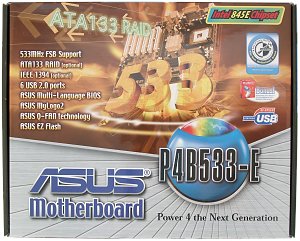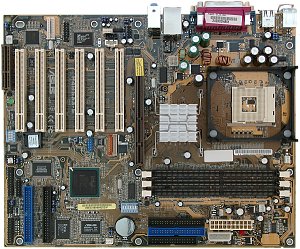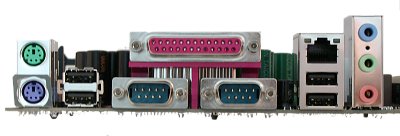ASUS P4B533-E (i845E) Mainboard
|


This is one of the most interesting products on the i845E chipset: almost
all features one or another model can boast of are gathered here.
Accessories:
-
Package of a standard design;
-
Documentation: user manual in English, brief installation manual in 11
languages;
-
Cables: 2 ATA66/100/133, 1 ATA33 and FDD;
-
Bracket with 2 IEEE1394 ports;
-
Bracket with 2 SPDIF-In/Out connectors (Coaxial);
-
Bracket with 2 USB and a Game ports;
-
Bracket for the rear computer panel;
-
CD containing:
-
drivers;
-
Adobe Acrobat Reader;
-
3Deep;
-
CyberLink VideoLive Mail;
-
CyberLink PowerPlayer SE;
-
ASUS Live Update;
-
ASUS HotKey;
-
ASUS Logo;
-
ASUS PCProbe;
-
ASUS Screensaver;
-
Winbond Voice Editor;
-
DirectX 8.1.

The layout has several typical flaws: IDE RAID connectors and audio-ins
are not in very good positions, and when a video card is installed it's
difficult to handle the IDE modules. It can be difficult as well to reach
some jumpers when the board is already installed. Their functions are shown
on the textolite.
The 3-channel switching voltage regulator incorporates 6 capacitors
of 3300 uF and 4 of 1200 uF.
The following controllers are integrated:
-
audio controller based on the C-Media CMI8738/PCI-6ch-MX chip supporting
5.1 audio systems and having connectors for front audio inputs/outputs
and for SPDIF;
-
network controller based on the chipset's capabilities and supporting 10BaseT/100BaseTX;
-
IDE RAID controller based on the Promise PDC20276 chip supporting RAID
0 and 1 on the ATA133 protocol
-
IEEE1394 bus controller based on the NEC D72874GC chip; 3 ports are supported.
Thanks to the ITE IT8708F-A Smart I/O controller the board supports (and
have connectors) readers for smart cards and SD and MS flash cards.
The board incorporates ASUS Multi-Language BIOS, ASUS POST Reporter
(reports about problems during booting), ASUS MyLogo2 (for displaying your
images when the system boots), ASUS EZ Plug (allows using a power unit
which doesn't comply with the ATX 2.03 standard), ASUS Q-Fan (auto fan
speed control) and ASUS EZ Flash.
+5 V supplied in the StandBy mode is shown by the green LED, and when
a 3.3V card is inserted into the AGP slot you will see the red LED which
means that the card is incompatible (it's impossible to turn on the computer
even with the Power button).
Non-unsoldered connectors: none.
The system monitoring is supported by the ASUS ASB100-A Bach chip. What
is controlled:
-
processor voltage, +3.3, +5 and +12 V;
-
speed of 3 fans;
-
temperatures of the processor (a built-in sensor), the board (a built-in
sensor) and an external sensor connected to the board.
There are 3 connectors for adjustable connection of fans.
Brief characteristics of the board: memory slots - 3 DDR SDRAM;
expansion slots - AGP/ 6 PCI /CNR; I/O ports - 2 COM/ LPT/ 2 PS/2/ 6 USB
2.0 / 2 IEEE1394 (the controller supports up to 3 ports); dimensions -
305x245 mm.

Adjustment can be carried out with:
| jumpers and switches |
Jumper to clear up the CMOS |
|
| Jumpers to choose a FSB frequency |
100, 105, 109, 133, 135, 141, 145, 166 and 200 MHz |
| Switches for setting processor's multiplier |
x8-x24 |
| Jumper for starting up computer from PS/2 keyboard |
|
| Jumpers for starting up computer from USB keyboard |
|
| Jumper for making Vcore voltage range wider |
Disable/Enable |
| Jumper for choosing an ASUS POST Reporter output |
Buzzer/Line-Out |
| Jumper to enable/disable SMBus 2.0 |
|
| Jumper for choosing a mode of the Bass/Center channel |
Bass/Center / Center/Bass |
| Jumper for enabling/disabling IDE RAID |
|
| Jumper for enabling/disabling IEEE1394 bus |
|
| BIOS based on the 6.00 version from Award |
Setup of memory timings |
+ |
CAS Latency, Active To Precharge Delay, RAS to CAS Delay, RAS
Precharge |
| Setup of memory frequency |
+ |
at FSB 100 MHz:
CPU/Memory = Auto, 1:1, 3:4
at FSB 133 MHz:
CPU/Memory = Auto, 1:1, 4:3 |
| Setup of AGP bus |
+ |
|
| Setup of PCI bus |
+ |
|
| Changeable scaler of AGP and PCI buses |
+ |
AGP (PCIx2) - from 66.66 to 104.46 in 0.4 - 0.8 MHz steps |
| Manual assignment of interrupts |
+ |
|
| Changeable FSB frequency |
+ |
100-200 MHz in 1MHz steps |
| Changeable CPU multiplier |
+ |
x8-x24 |
| Changeable core voltage |
+ |
1.5-1.9 V in 0.025V steps |
| Changeable memory voltage |
+ |
2.5, 2.6, 2.7, 2.9 V |
| Changeable chipset voltage |
- |
|
| Changeable AGP bus voltage |
+ |
1.5, 1.6, 1.7 V |
We used the latest available version of the BIOS - BIOS 1008 beta 002.
The board is traditionally good; there are no drawbacks except a quite
high price. But believe me, the board's worth it.
Test results:
Write a comment below. No registration needed!
|
|
 |
|
|
|



